Notes on Post-Pandemic Business Travel
I spent much of last week in Salt Lake City, where I spoke at the ACES Conference for Apple consultants and managed services providers (many of whom are TidBITS Content Network subscribers). It was my first conference and solo business trip since the pandemic started in 2020, and it took some time to update my travel gear and habits.
Packing Pro
I’m surprised I haven’t written about Packing Pro, the iPhone app I’ve used since 2018 to generate trip packing and preparation lists. It’s essentially a well-constructed and easy-to-use database dedicated to trip planning.
You create a trip, which has a name, dates, and notes. Then, you add items you want to pack, selecting them from an extensive pre-defined collection, along with tasks you need to accomplish before leaving (watering plants, refilling the cat food, hiding backup drives just in case a thief absconds with computers, etc.). As you assemble your suitcase and work through your jobs, you mark those items as completed in Packing Pro. That’s it, unless you’re even more OCD (obsessively cataloging data) than I am, at which point you can add all sorts of metadata to each item.
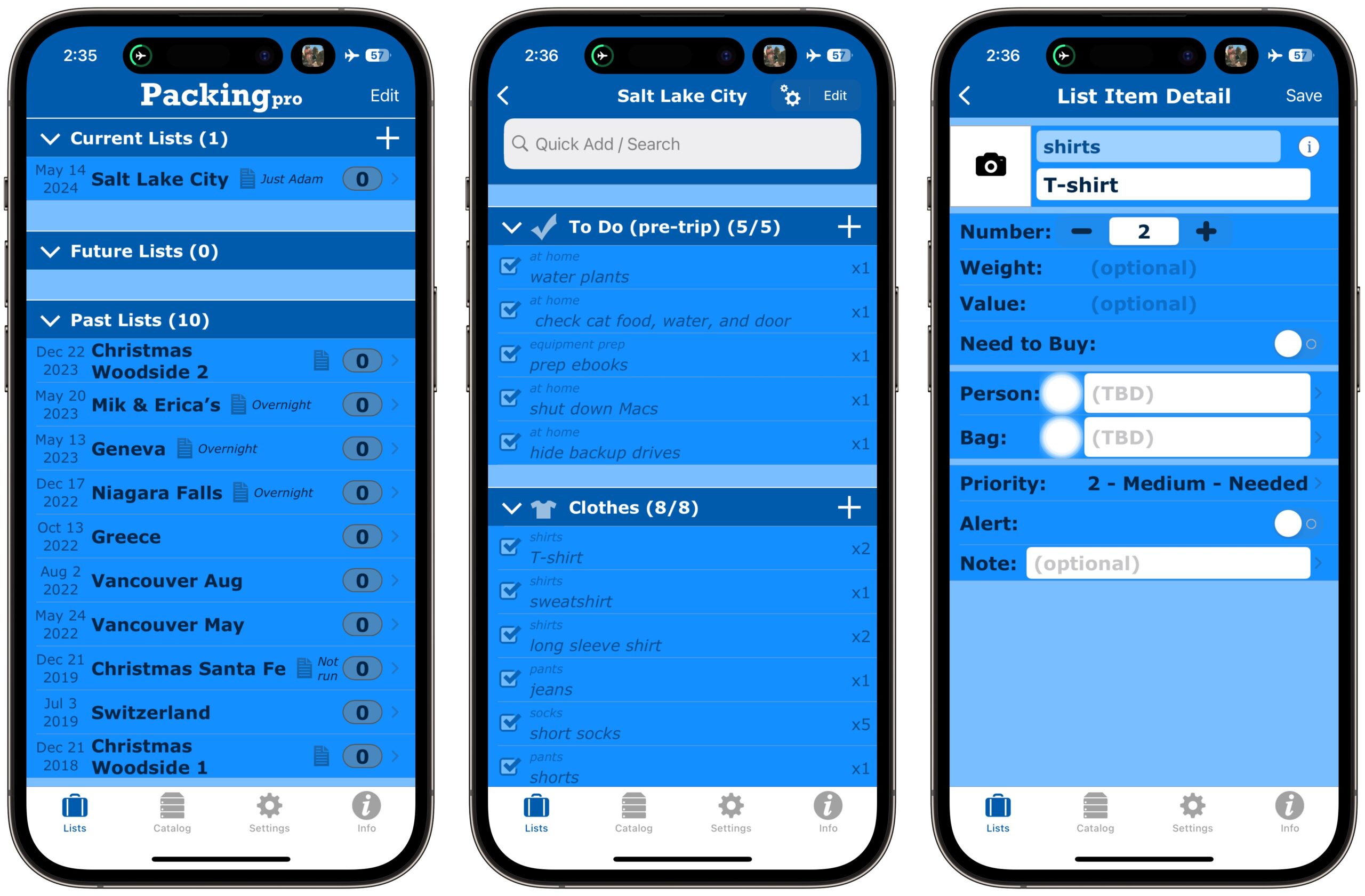
What I like most about Packing Pro is that it remembers each trip, making it easy to replicate a previous packing list. Before Packing Pro, I had a simple Nisus Writer Pro document that I’d print and manually adjust for each trip, but a week-long family trip to California for Christmas requires rather different preparation than a several-day solo trip to Salt Lake City in the spring.
Packing Pro may not feel as though every pixel has been placed by a hipster designer, but developer Quinn Genzel has seemingly thought of everything when it comes to functionality. You can sync your lists via iCloud, share them (via email, AirDrop, Dropbox, Box, iCloud Drive, and email), customize the master catalog of over 400 items however you want, tweak the design, and more. It has a one-time payment of $2.99 (a few optional $0.99 in-app upgrades are also available) and is well worth it if you obsess over your data as much as I do. (I’m a piker—you should have seen my grandmother’s packing lists!)
Flighty
I’ve written about how airline apps have become extremely helpful (see “Using the Delta Airlines App and Apple Business Chat in a Snowpocalypse,” 15 November 2019), but this was my first test of Flighty, an independent flight-tracking app that’s a poster child for Apple technologies. Like Packing Pro, it’s essentially a database of information surrounding a trip that tracks flight numbers, arrival and departure times and gates, plane locations, historical arrival times, and much more. Unlike Packing Pro, Flighty has a gorgeous, modern design and provides a Lock Screen widget, displays Live Activities in the Dynamic Island and on the Lock Screen, and keeps you up to date with an elegant Apple Watch app.
You seed Flighty with flight numbers on specific days, and you can differentiate between your flights (which Flighty tracks forever) and those of friends (which it deletes after you’ve made your airport pickup run). A top-level My Flights screen summarizes upcoming flights underneath a map showing the flight plan. Tap a flight to focus the map on the plane and see more details. The map can show weather radar and even other planes nearby.
Oh, the detail! Scroll down to see vastly more data, including timezone changes, arrival weather, what type of plane you’re on (I’m sure Boeing 737s are TOTALLY FINE NOW), a detailed timetable, contact information for the airline, your history on that route, and even an archive of updates. Those updates can make Flighty a little chatty—tone it down in the settings if you want—but as someone who finds information reassuring, I appreciated knowing that the incoming plane for my next flight was 7 minutes late.
The more I poked at Flighty, the more impressed I became. The developers are serious travel geeks, so the app automatically builds gorgeous screens for the Flighty Passport that tracks all your flights (even extracting past ones from calendar events); reports on your total, average, and worst delays; and reveals details about which aircraft you’ve flown and how old they are. Such data is purely interesting trivia for me, but someone who travels regularly for business could use it to discover trends to improve their travel experience.
Flighty’s Apple Watch app is also well done, with a top-level screen showing flights and three detail screens for each flight showing progress, departure, and arrival information. I use my iPhone heavily while on planes, but I could imagine times when you wouldn’t want to haul it out just to check progress.
Many of these capabilities may be overkill for those who seldom travel. The American Airlines app did an acceptable job of alerting me to flight information, and you still need it (or the equivalent from another airline) to check in, add boarding passes to Wallet, and deal directly with the airline. In fact, the American Airlines app one-upped Flighty by providing time estimates and directions for walking between gates, something that can be a source of stress on tight connections.
Frequent flyers will most appreciate Flighty, but even casual travelers (or those who often pick people up from the airport) will find it helpful. At its base level, Flighty is free, and everyone’s first flight with Flighty receives all the Flighty Pro features for free. They include real-time flight tracking, push notifications, calendar sync, email import, delay forecast, plane locations, and more. (I have a test version of Flighty Pro, so I’m not entirely sure which features I’d miss if I lost access to the paid features.) Subscribing to Flighty Pro costs $3.99 for a week, $5.99 for a month ($10.99 for a family), $47.99 for a year ($89.99 family), or a single $249 purchase for a lifetime license ($449 family).
T-Mobile In-flight Wi-Fi
Life has been busy of late, and my talk for the ACES Conference wasn’t as far along as I wanted by the day I needed to leave. I would have to work on the airplane. That’s no hardship—I appreciate activities that distract me from the “Why aren’t we there yet?” feeling—but in my world, it is actively difficult to work without Internet access. On the way home, this article clamored for my attention—taking the entire day off would make for an even busier weekend.
In-flight Wi-Fi is expensive—it varies by flight but would have cost me $19—but then I remembered that T-Mobile provides free in-flight Wi-Fi as a benefit. A little research in the T-Mobile app on my iPhone confirmed that my Magenta plan provided either four total flights of Wi-Fi per year or an unlimited number of 1-hour-per-flight Wi-Fi sessions for streaming. I’m now down to two full-flight sessions.
Enabling the T-Mobile free Wi-Fi was easy enough, if non-obvious. Once I activated Wi-Fi on my iPhone and was shown the American Airlines landing page, I had to scroll down to find a button that loaded another page. There, I had to switch to a Free Services tab, tap a T-Mobile button, and enter my phone number. Performance via the satellite Internet connection was decent, and I had no trouble loading websites, working in Google Docs, and more.
What I couldn’t do was get my MacBook Air fully online the entire time. Although the American Airlines landing page provided a button for transferring purchased access from another device, it asked for the email address used to purchase Internet access. It wouldn’t take my email address or phone number, and I couldn’t figure out any way to transfer my T-Mobile session. (On the second flight, where I cared more, I discovered there was an option to ignore an ad in exchange for 20 minutes of Wi-Fi connection time. I’m very good at ignoring ads.)
Not having my MacBook Air online much wasn’t the end of the world. I do all my writing in Google Docs and have the Google Docs Offline extension in Arc, and since my documents were already open in Arc tabs, I had no trouble writing offline. I was even able to take the iPhone screenshots above and send them to the MacBook Air using AirDrop.
USB Type-A Isn’t Dead Yet
My current devices are an iPhone 15 Pro and an M1 MacBook Air, which sport only USB-C ports. I brought Apple’s two-port 35-watt USB-C charger and a pair of USB-C cables for the MacBook Air and the KU XIU X55 MagSafe charger I planned to use in the hotel to charge the iPhone, my Apple Watch Series 9, and my AirPods Pro (see “Going All in on MagSafe for the iPhone in the Office, Bedroom, and Car,” 6 May 2024). That all worked swimmingly—points for USB-C simplifying things.
But I hit my iPhone’s battery pretty hard on the longer flights between Chicago and Salt Lake City and wanted to charge using seatback power. Which had only USB Type-A jacks. Charging cables for which I hadn’t thought to bring. Luckily, it turned out that Past Adam had long ago packed a USB Type-A to USB-C cable in my dongle bag, and once I discovered that fact, I was able to charge my iPhone while working. I could also have charged directly from my MacBook Air, of course, and the planes also had standard power outlets, although they weren’t turned on until sometime in the middle of my first flight.
The moral of the story is to make sure you always pack a USB Type-A to USB-C cable. I was so caught up in thinking that I only had USB-C devices that I failed to remember the ubiquity of USB Type-A jacks. In a bit of serendipity, the conference sponsor swag included a braided charging cable with USB Type-A on one end and a hydra-headed other end that provides USB-C, USB Micro-B, and Lightning. That’s now living in my dongle bag.
TSA PreCheck
For my flight home, I ended up with an early afternoon boarding time, so I got to hang out with a friend from the conference at breakfast and on the way to the airport. We found the entrance to the security checkpoint, and my friend headed for the TSA PreCheck line. When I commented that I didn’t have TSA PreCheck, he gasped—it was as if I revealed I didn’t have indoor plumbing.
My excuse is that the last time I looked into TSA PreCheck, probably in 2019, it required signing up at a large airport. We may have indoor plumbing in most places in Ithaca, but we do not have large airports nearby, so I’ve been taking my shoes off—it’s amazing that we hicks even wear shoes, I know—every time I go through airport security. As we were having this conversation, three other conference attendees wandered up, and of course, they all had TSA PreCheck as well. I was clearly the rube.
But my friend let me in on a secret. Starting in 2018 and with increasing rollout through 2021, the office supply store Staples has provided the in-person side of TSA PreCheck signup. Who knew? And we have a Staples in Ithaca! Of course, when I checked the Staples website, I discovered that, presumably due to our lack of universal indoor plumbing, I would have to drive 30 miles to the Staples store in Elmira instead. The next closest option would be the Syracuse airport, which is twice as far away.
Now I have to decide if it’s worth doing TSA PreCheck or if we should figure out how to schedule a trip to a major airport to get Global Entry.
App Clips Live!
Unusually for me, I ended up with enough time at the airport to eat a sit-down lunch with two of my friends from the conference. The food at the Gourmandise Euro-Diner & Bakery was entirely edible and shockingly quick to arrive, but what surprised me was their payment approach. After our food came, the waitress printed out a QR code-emblazoned bill for each of us.
Scanning the QR code opened an App Clip, only the second time I’ve encountered one in the wild (see “Tech Notes from a Cross-Border Trip to Canada,” 13 June 2022). Whereas my previous App Clip was entirely unnecessary—I could have just paid for gas at the pump with Apple Pay—this one was a nice shortcut. In this case, I tapped the Open button, approved the Apple Pay process, and received a receipt. One of my friends stumbled over a request to sign up for an account (I already had a Toast account), but his payment went through anyway, and although he wasn’t sure if it had, when he tried again, the system helpfully informed him that the bill had already been paid.
This use of the App Clip technology was effective thanks to the QR code, which provided an easy way to link my order to Apple Pay. The waitress could have used an NFC-capable terminal to accept digital payment for the meal, but that would have required her to interact with each of us, which would have been slower and kept her from other tasks. Instead, the QR code let each of us pay separately at our own pace. And I’m sure the system alerted her that we’d paid.
So that’s two App Clips in four years for me. How about you—have you seen an App Clip, and was it helpful?
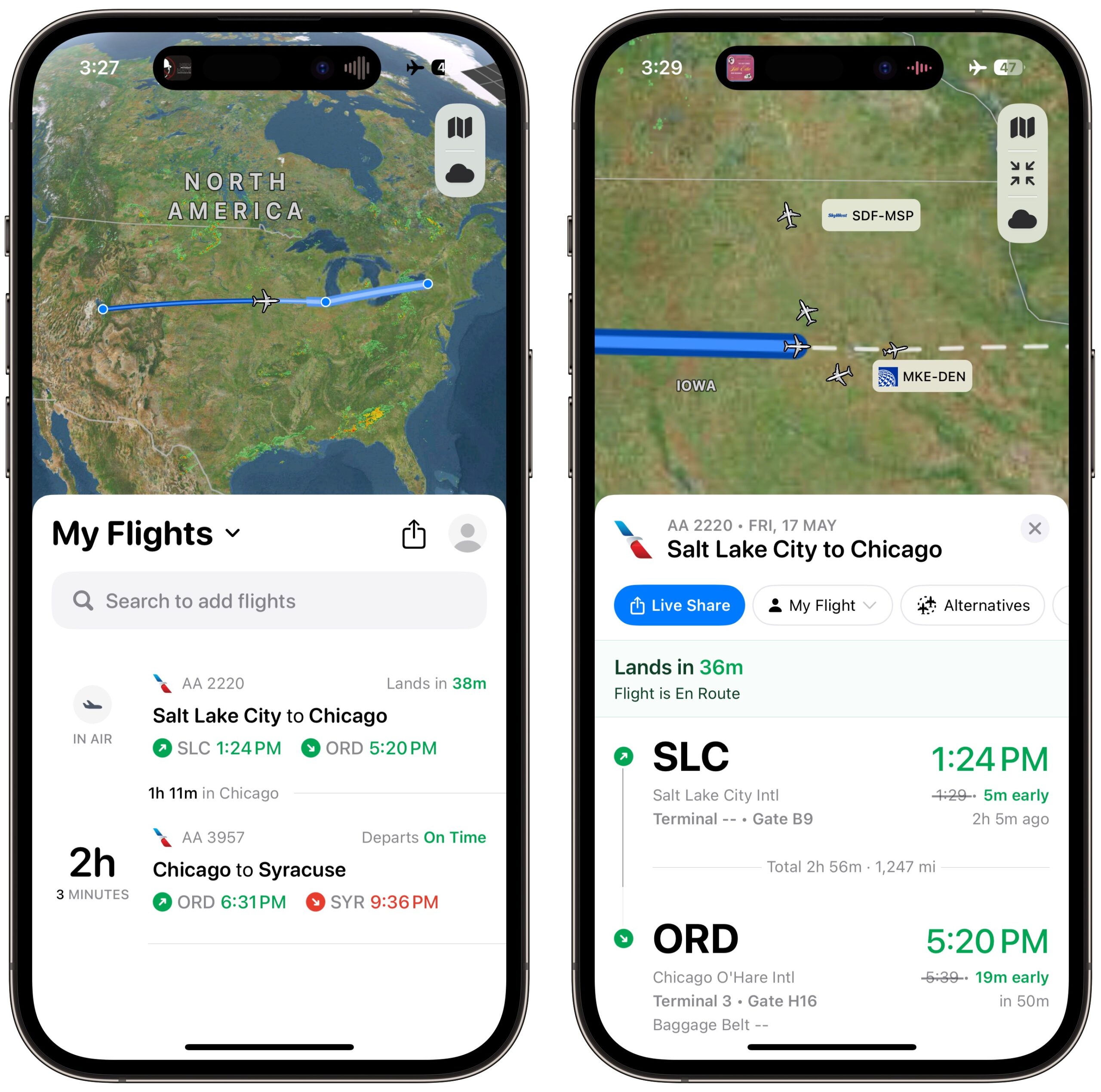
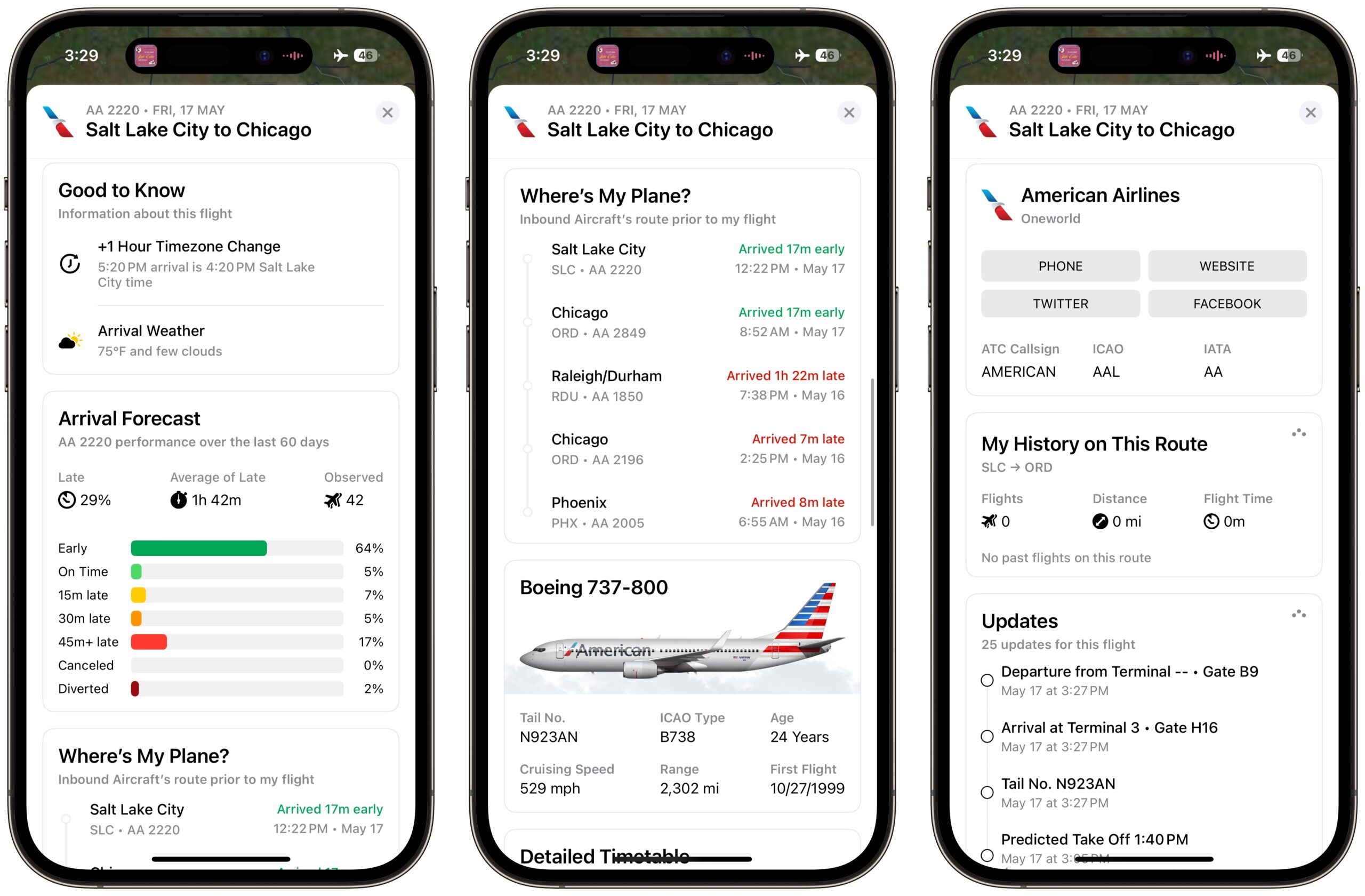
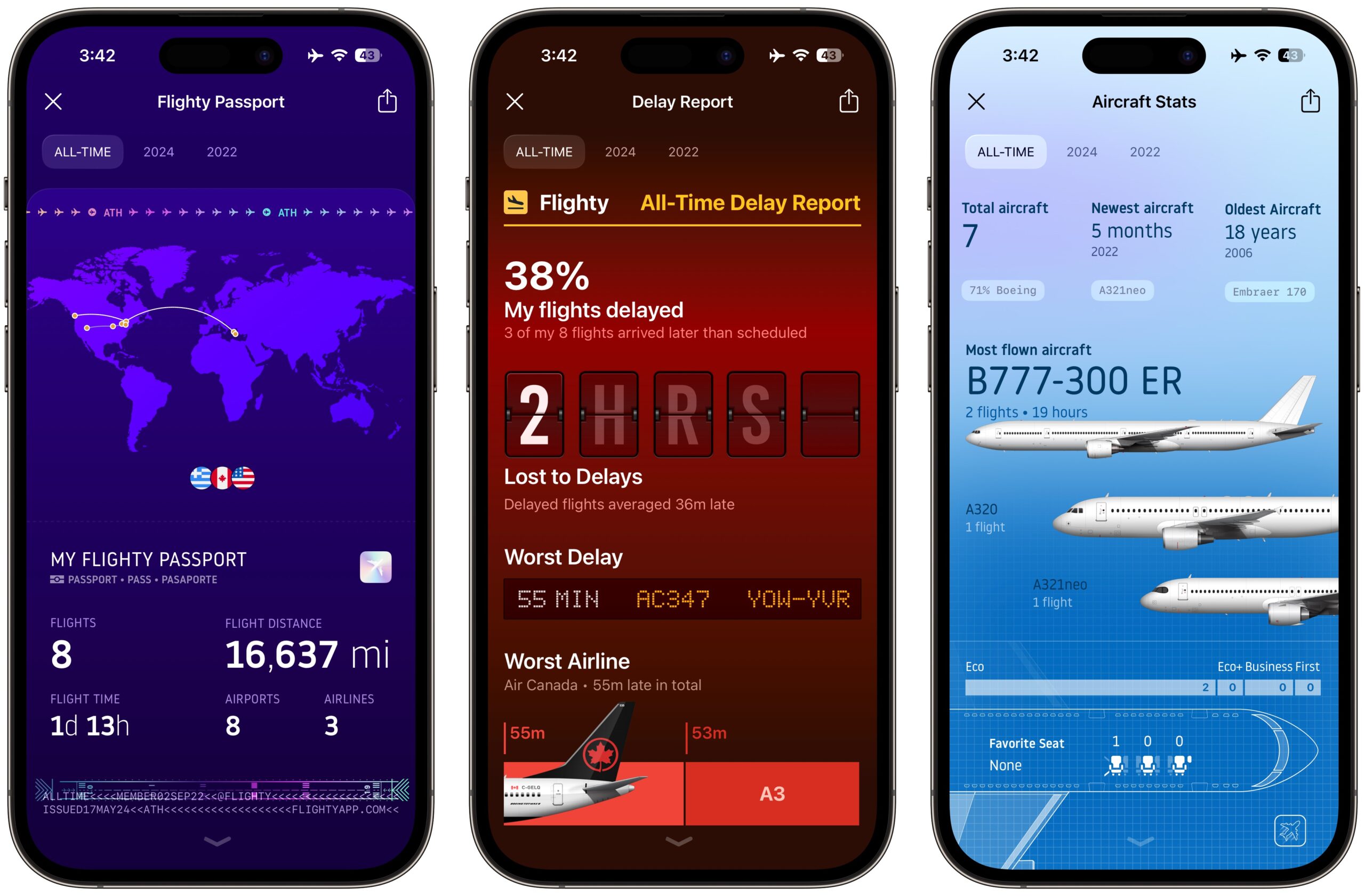
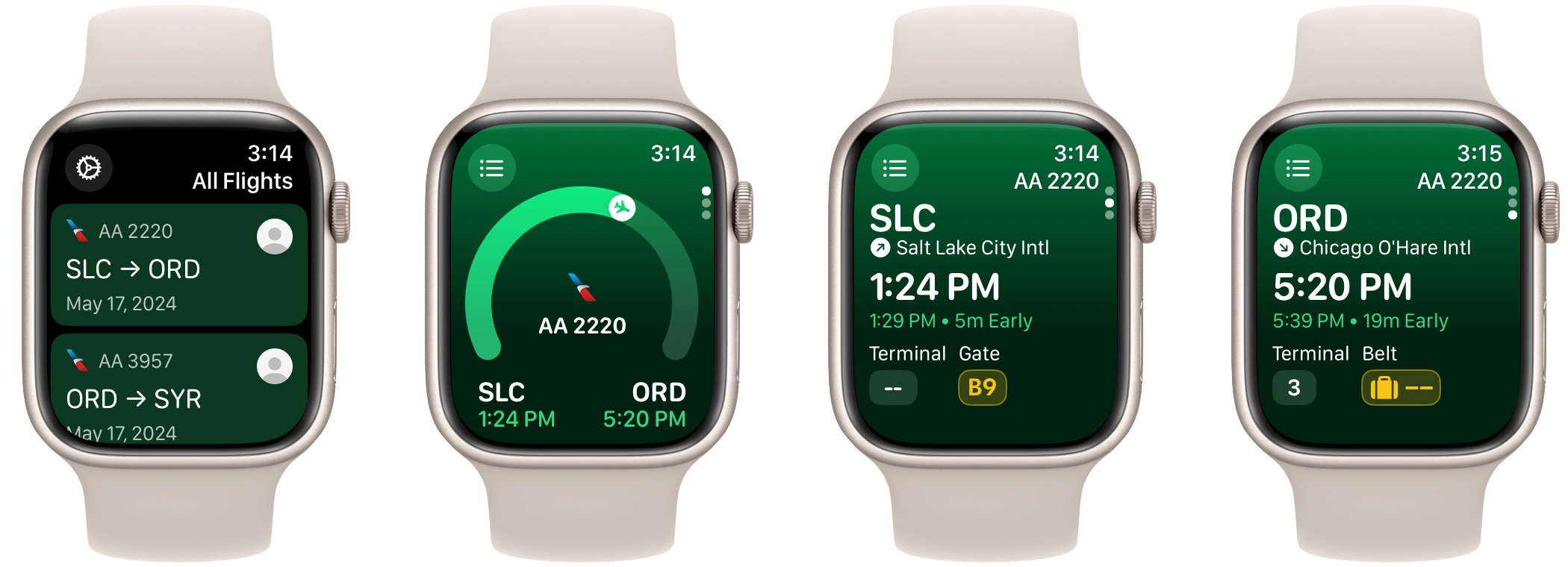
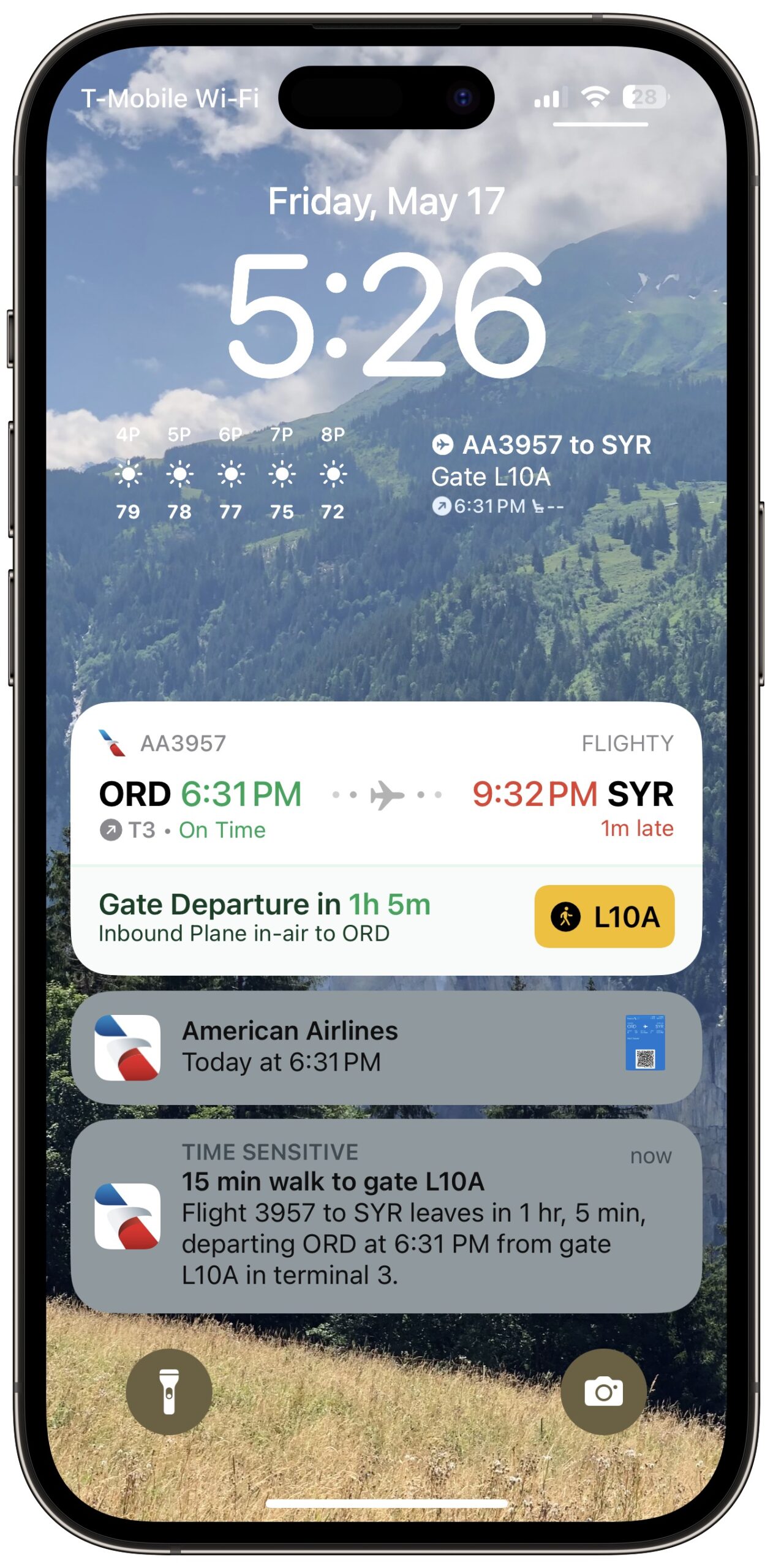
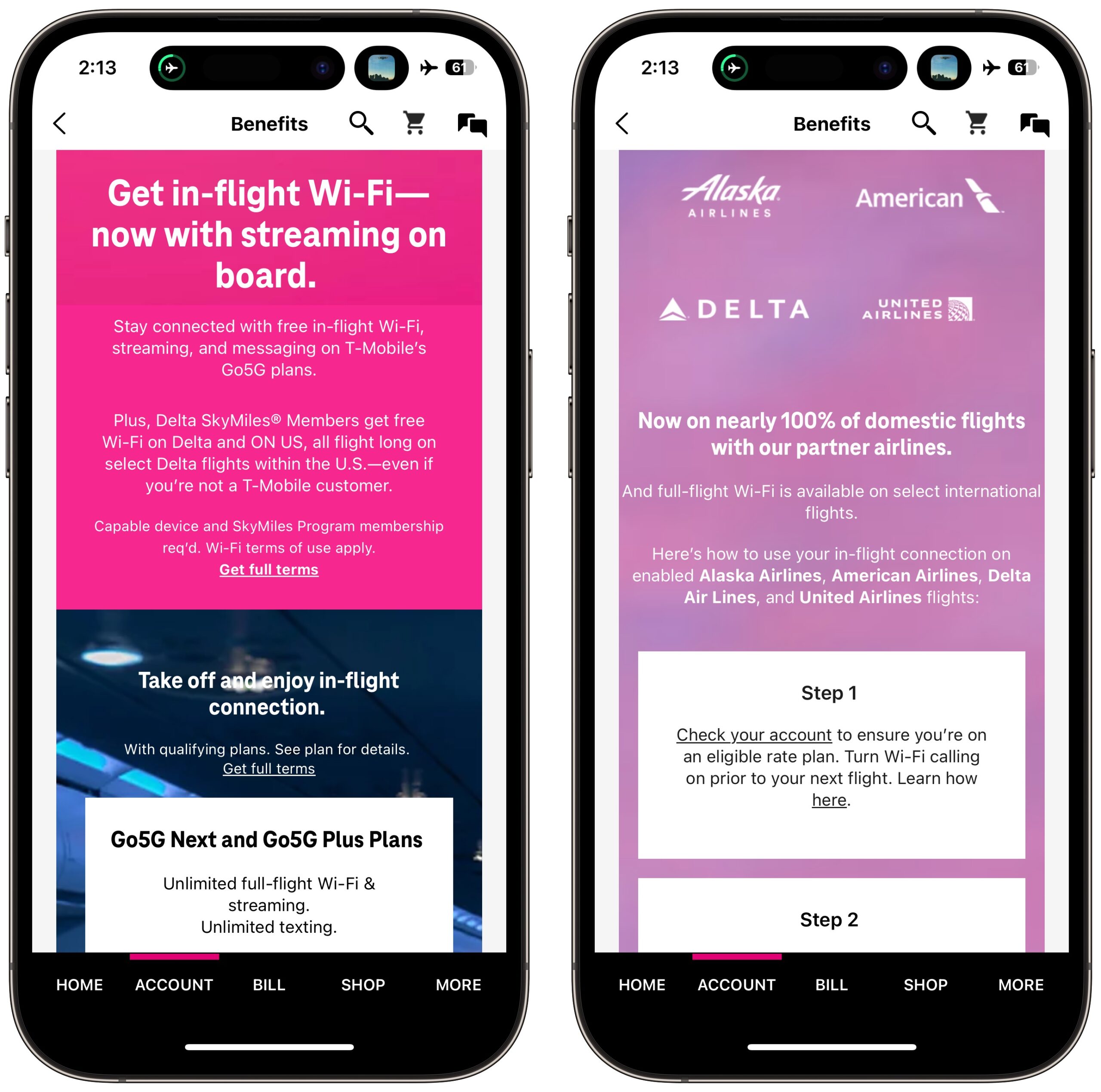
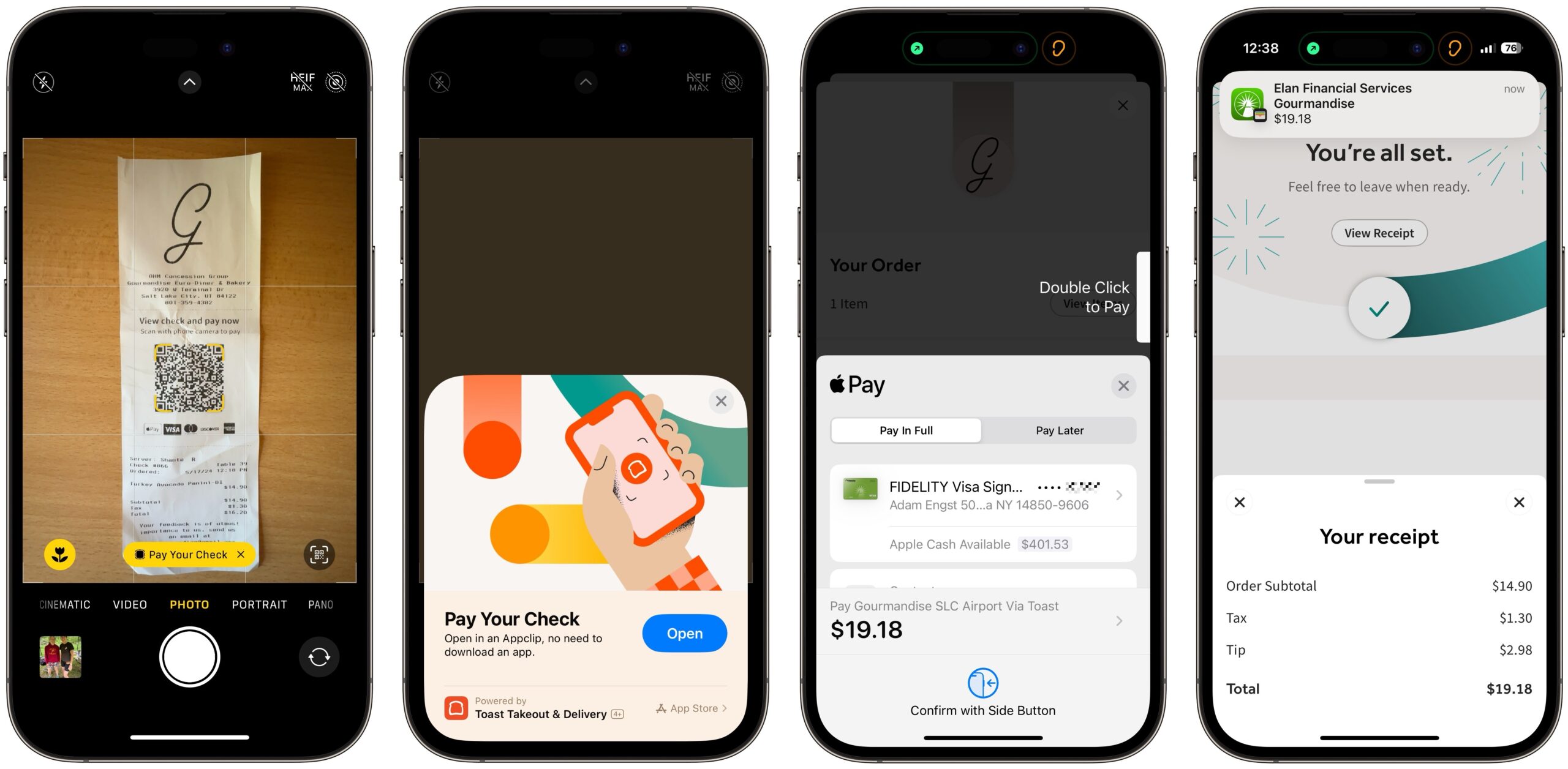
If you routinely fly one airline, it’s definitely worth downloading and reading their Contract of Carriage (probably a PDF.) Here’s the page for United’s CofC: https://www.united.com/en/us/fly/about-contract-of-carriage.html That’s your friend if there are problems en-route, as it lays down the airline’s legal responsibilities and commitments. (Once in Montreal, I helped a passenger and the gate agent, by showing the gate agent where the contract of carriage allowed him to rebook a passenger from Newark to LaGuardia under the contract’s “equivalent airports” clause. The gate agent wasn’t sure if he could do that without collecting a fee (not his airline), so he was happy to see the language that authorized it.)
If you have reason to fly to/from Canada (like you do, Adam), then Nexus might be the better option. It is the option for Canadians with regular business or leisure travel to the US. For Americans who visit Canada, it gives you similar benefits to TSA PreCheck within Canada and when flying Canada to US. I admit I was sceptical when my wife said she was getting Nexus because a busy year for us would be 3 round trips. (I did end up getting one as well.) But on those days where the line at security is super long, having Nexus takes a bunch of stress (and waiting) out of the process by giving you the “short line”.
Seconded for these reasons, but also because I suspect it’ll be easier for Adam to get to an enrollment center… there are a few at US/Canada border points in NY, which might be a more easy/feasible trip. I used to live in Western NY and didn’t go to Canada enough to warrant NEXUS by itself, but I still keep my NEXUS membership up to date for the PreCheck and Global Entry benefits.
Good article. Thanks for the tips. And now some random comments of mine.
FWIW, I always travel with at least one AC adapter brick in my carry-on bag. This lets me charge in the terminal from any outlet without worrying about random USB jacks (I realize that juice jacking hasn’t been seen outside of proof-of-concepts at security conferences, but I’d still prefer to not take a chance).
Unfortunately, even when planes have AC outlets, they are often so abused that a power adapter can often fall out within seconds after insertion. So I frequently find myself using the seatback USB-A ports while in flight.
I too haven’t bothered with PreCheck or Global Entry. I fly maybe once per year, so it just seems like a waste of money for me. In order to avoid the stress of long lines at the security checkpoint, I recommend (and do):
Once I’m past the security checkpoint, that’s when I can relax. I carry the tubs to a table or bench and take my time putting my stuff back where it belongs. Then, since I (usually) have plenty of time before boarding, I can leisurely walk to the gate and find a place to get a meal.
One final tip, especially for long domestic flights. Food isn’t included (hasn’t been for some time) and the stuff they sell in-flight (at least for economy class) is lousy and overpriced. So take some time (you should have plenty if you arrive as early as I do) to buy your own carry-on meal in the terminal. I can usually find a sandwich shop near my gate, so I’ll go there to buy lunch, carry it on, and eat it in-flight.
Regarding the Global Entry interview:
There is a program that allows you to satisfy the interview requirement upon arrival from an international location. So, you need to apply and then allow time for the interview when you arrive home from your first trip (unless you are flying to an international location that also can do the interview:
I took one U.S. trip last year for the first time since the pandemic, and another one this year. I just create a folder for the trip in Notes (e.g. Boston St. Louis Trip 2024) and have notes in there, with checklists.
As far as GlobalEntry goes I will note that when we renewed ours my wife was asked to do the interview via Zoom. Not sure if that would apply to new applicants.
We do a similar thing, but I have a shared folder with my wife with at least one note for each trip, and we add PDFs received, new plans, etc., here. (I’ll print emails to PDF and share them to the note to get those added, as mails don’t have an easy share sheet control.)
These details also go into my TripIt account, which syncs with our calendars, but it’s nice to have the notes to verify confirmation numbers, etc., when checking in to hotels, flights, etc.
Is there any meaningful advantage in using Packing Pro over OmniOutliner? I use OmniOutliner to plan my Scout trips, camping trips, etc., and it seems to do most of what you use Packing Pro for, plus has general utility as a list-making app.
IMHO for frequent international travel you want CBP’s MPC app. In my experience entering the US at various airports after travel abroad, lines are often much shorter for MPC travelers. Unlike scammy “fast track” subscriptions, this app doesn’t cost a thing and lets you answer CBP questions and submit your entry form while you’re still seated as the aircraft pulls into the gate. The only catch is it will only work for US citizens, and these days I believe also Green Card holders.
+1. The MPC app is simple to use and faster than the paper customs declaration.
The last time I used the MPC app (several years ago, entering the country via JFK in New York), the MPC lane just ended at a kiosk which scanned my phone and printed a piece of paper (with all the same information I would’ve written on the paper declaration form) which I had to hand to the CBP person along with my passport. It didn’t save any time over doing it by hand, and might have taken longer because I needed to wait for the kiosk to read my phone and print the slip.
But that was several years ago. Maybe somebody grew a brain and fixed it since then?
You know the irony now with Apple is that their products finally offer USB-C ports for charging BUT Apple doesn’t offer an OEM Apple legacy USB to USB-C charger cable. Sure, you can get a non-Apple Belkin for $20-$30US on the Apple store. Or cheaper 3rd party cable solutions. But for some of my faculty that travel and recently were upgraded to iPhone 15Pro models, they too, realized on a flight as well as rental car, that USB-C is not a standard. So now, when I have to order upgrades for others, I need to also order a 2m USB-C charge cable, as well as a legacy USB to USB-C cable (in 2 lengths…one for their car and one for other). I also get that 2 in one charger since some have spouses/partners and two USB-C devices to charge. And yeah, there is a International charger I found that has USB and USB-C charge ports.
FWIW, the last two times I flew into the US (last April and this past January) there was absolutely no form at all. In January, the immigration officer asked if we had anything to declare, and let us pass through after we answered no. (He also asked if we had any alcohol.) Last April we cleared immigration and customs in Ireland and, again, no paper forms, no MPC app.
We have Nexus because we’re only a few hours from the Canadian border and thought, when we brought the whole family up for our interviews in JANUARY 2020 we would enjoy the ease of crossing into Canada as well as getting Global Entry and TSA Pre benefits.
I have not returned to Canada since well before that, for reasons of pandemic! I have two trips planned for business this year, so it will be helpful. And I have six flights last year and two international ones in the last two years, so the TSA Pre and Global Entry parts were great!
It’s also only $50 for five years.
Two downsides, though! You have to go to near-Canada city for the in-person interview with both US border control and Canada border control. Second, they’re so backlogged, that I believe it is 9 to 12 months to schedule an interview at some lcoations. For Adam and Tonya, it’s Champlain, Ogdensburg, or Niagara Falls, NY! We just go to Blaine, a bit north of Bellingham.
I expect to fly more in the last couple of years, but then had a blowout last year with two business-related trips (paid by other people), two research trips, a visit to my older at college cross-country from us, and our long-delayed family 2020 trip! I think it was 50,000 miles and 14 segments. I did earn status on Alaska, and have gotten free upgrades on there of my four Alaska segments this year so far (twice to first class…on small planes for short distance.)
The title of this article is infuriating. The world is not at all “post-pandemic.” The WHO decided to end the “emergency” status, but the COVID pandemic is still very much with us. Pretending otherwise is delusional and shameful.
#CovidIsNotOver #CovidIsAirborne #CleanAir #WearAMask #CovidVaccine #LongCovid
I check with Flighty and since 2022 I’ve been the equivalent of 1.8 times around the world.
I have to say post-lockdown my wife and I positively sprang onto a plane to remote Croatia, heat, swimming in warm seas… too long.
I’ve downloaded the Packing Pro app, a three country trip this June and an extended stay in Italy at the end of the year coming up. I am notorious in my family for emergency purchases while abroad. Never any issues with tech but have been known to travel without underwear.
Excellent advice, @Shamino
A couple of suggestions:
I wrap a couple of rubber bands around the power adaptor and have often been able to use one to hold the adaptor in place in a loose receptacle. They often come in handy in other random ways, as well. Rubber bands (and twist-ties) are really useful.
Even though I don’t travel an enormous amount at the moment, I’m very glad for my PreCheck, just for the ability not to have to take my shoes off/take my laptop out/etc for security.
I usually wear a jacket with large pockets and I can just put everything in the jacket, take the jacket off, and put it in the bin. It’s quick and since I have the jacket on as I’m doing it, I don’t have to worry about holding a plastic bag in addition to everything else while I’m shoveling things in.
Excellent advice – just, for the sake of your fellow passengers, don’t get anything really smelly.
A couple of other recommendations:
Packing cubes are a god-send for packing/unpacking. I also usually put one with a complete change of clothes in my carry-on (if I’ve checked my main bag). Good emergency backup.
I have duplicates of all my toiletries at home and just leave them packed in my kit. When I pack, I just grab the kit and I’m ready.
AirTags in all my bags! Even carry-ons, in case they get lost/stolen.
As Kevin below noted, TripIt is super useful.
Glad to see Packing Pro getting some love. Not elegant design (and there are a few things that could be altered) but absolutely indispensable for me (I go international at the very least 4x per year, and many domestic flights too; half a million miles, 79 cities 20 countries).
GOES is well worth it. NO taking off shoes, NO taking out computer. Don’t even have to take off a jacket (though a phone or whatever should be run through the x-ray of death scanner).
TripIt is also super useful. You just send them your confirmation email from the airline and they format the data for your app. That’s also where I got the travel-stats I cited above. Fun!
Rather than mess with the provided outlets, I just carry an Anker power bank. It’ll charge up my iPad, iPhone, iPods and anything else for even a 20 hour trip.
But seriously, PackingPro!
I do the same with electronics: I have an Anker charger that has AC and USB outlets on it, along with all the cords for my phone, laptop, iPad, watch, etc. When I travel internationally, I add a foreign plug adapter. It’s all in a bag, always ready to go, so when I travel, I just bring the devices and I don’t have to worry about cords or charging bricks. So much less stressful it’s worth the duplication expense. (And one time of having to buy an emergency replacement overpriced cord or charger at an airport or strange city will actually cost you more.)
I did have to replace my old charger when Apple switched to USB-C, but now it’s nice that a single USB-C cord will charge almost everything.
I have successfully used this kind of USB adapters.
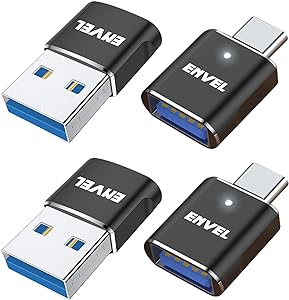
If @ace doesn’t mind and since it’s trending in that way already, what are everyone’s best travel tips? Not necessarily tech related. To the ones I mentioned above, I’ll add that unless it’s incredibly hot out, I try to wear a jacket that gives a bit of warmth and has lots of pockets. Planes/airports can be uncomfortably cold even in summer, and you’re always taking/getting handed/acquiring things that you have to put somewhere quickly. Good pockets are underrated.
If you are flying on a plane that can take a 3-pronged UK adapter, you can use a universal charger. The third prong (usually plastic on an adapter) stabilizes it in the outlet.
Like another response…I have a travel cords bag so I don’t have to pull the normal ones from the recliner. It’s got more than I need so I just pull what I or we need for this trip. The bag Lao has password wallets, travel scale, scoops and cable ties for whatever, and I just pull out what is needed.
The other big help is a standard trip prep list we developed over the years and keep in Notes…it gets duplicated for each trip and includes everything from week before to day before to clothes, electronics, camera gear, food if we are taking it, tickets, reservations and a reminder to put the garbage out…not everything is applicable to every trip but the latter has every possible item and after duplication the not this trip stuff gets deleted from the specific list. We started this idea back when we lived full time in the RV to ensure we didn’t forget anything vital or not…and when we find something new it gets added to the master list. Having a checklist prevents a lot of did I pack that questions. Items like clothes include everything from stockings to jewelry and hair scrunchies…down to bathing suits and assorted shoe types…because it’s easy to forget something vital. Those things are mostly easily replaced while on the trip…but then you end up with 2 of them.
And we use an always do it this way thing…for instance every time we leave the house we say door down to each other to verify the garage door is really closed after backing out…I learned in the Navy that standard procedures and always the same order and the same words makes muscle memory a lot simpler.
Or realistic and rational, depending on your understanding of statistics.
Ha! I go the opposite and just wear a windbreaker that can be scrunched up and stuffed into my bag in virtually no space when I don’t need it. But then I run hot and I hate having to take off a coat at an airport or on a plane and then have to carry it.
Last month I had a week in Paris with stops in London and Germany and other than two instances of rain – both just a few minutes long – and one evening where it was a bit chilly, I was fine with the windbreaker. It has a hood which helped with the rain. I walked about 8 miles a day in Paris and London and was plenty warm most of the time. I did take the windbreaker off on the plane home and I was glad I could. The Frankfurt airport had me walking so far and going through so many crowded lines I got very hot.
COVID is now considered endemic like influenza, so yes we are “post-pandemic”. Just get your annual covid shot when you get your annual flu shot; supposedly both annual vaccines will soon be combined into one shot.
I don’t think this is on-topic…or likely to be productive.
Probably not. It’s nice that Packing Pro has a pre-built database of stuff you’re likely to pack, but that’s minor. Any checklist-like app would also work, as long as you can easily replicate one trip for the next.
Agreed. No more posts on whether you think we’re post-pandemic or not, and I’ll remove any that do appear.
Same here. I usually take off my coat and shove it into my checked bag after I get to the airport.
Which works great, except for one trip to Europe, where the destination airport didn’t use a Jetway for deplaning. I had to walk down the flight of stairs and about 100m to the building (and the line was moving rather slowly for some reason) in freezing cold weather - with my coat in my checked bag.
THIS IS WHAT I MEAN.
Sorry, yelling. My go to is an LLBean barn coat. Reasonably light weight, lots of pockets, but can be pulled around you for a fair amount of warmth.
Just a comment on anTSA item: When my wife and I signed up for TSA PreCheck, way back in 2018(!) the in-person part of the signup was done at a contractor’s office. It was some sort of security business that had a contract with TSA. Not far from home here in the sticks of Dover, DE. (Yeah, capital of the first state but still in “the sticks” ) We just made an appointment as part of the online sign-up page. Pretty convenient.
) We just made an appointment as part of the online sign-up page. Pretty convenient.
I guess things have changed since then. I did see where you could now do it at airports or major businesses like Staples but I just assumed that was in addition to…
Anyway, maybe it’s still an option but not obvious. BTW, renewing, was completely online - no in-person required.
Bob
Less than two years ago, my wife and I signed up for TSA PreCheck and they directed us to a local business a few miles away for the in-person verification. IIRC it was an independent insurance agency office that also did Live Scan and took passport photos and the like.
My wife and I just got our TSA PreCheck KTNs in March. Based on the TSA website, there are apparently 3 private companies issuing them: CLEAR, IDEMIA, and TELOS. The fees vary slightly and IDEMIA has 620 locations, TELOS has 28, and CLEAR has 6 locations. We were referred to a AAA Northeast office near us, although there were also Staples and others near us (Long Island, NY). We got our numbers within about 2 business days for about $70.
I think most of mine have already been mentioned.
I don’t have pre-check of global entry, though, because, frankly, I am one of those people who gets to the airport long before it’s probably necessary and long lines just don’t bother me all that much, and the last few times I have come home from international flights I’ve had to wait no longer than about 5 minutes at immigration, and I am either returning to my home airport, or I have a decently long layover wherever I clear immigration. I do have sneakers that I can easily remove and put back on without tying/untying laces, and while I am in line all of my small pocket items are going in to my backpack (Apple Watch, phone, coins, wallet; keys are already there.)
For several major trips overseas now I’ve made PDFs of all my critical info documents (airline, accommodation reservations, medical and health stuff, insurance, etc.) and keep them in a folder in Notes “On My iPhone” as well as having access to them via iCloud folders.
Great tips from everyone, especially for Packing Pro. These are some of my current practices:
Precheck is essential for me. I’ve flown about a dozen or two times since pandemic now and I’m always grateful for the time it saves. Recently they added Delta Digital ID at JFK which frankly is amazing. Once you sign up, you can pass through a dedicated line with nothing more than your face. No boarding card, no government ID, nothing! It’s based on facial recognition obviously and it’s really fast. For now at least the lines are really short, too, so passing through this line feels like extremely special service. Can’t recommend it enough, and another reason why I stick with Delta when I fly.
Oh another tip: those who don’t use TripIt or a similar flight organizing service are truly doing it the hard way. Manually collating this info is a huge waste of time and TripIt makes it almost effortless. I used that service for many, many years but I recently switched to Tripsy which is about 95% as good but much more iOS native (i.e., the design is beautiful), for those who care about that sort of thing.
Those facial ID machines are all over Europe now.
I’ve long known about NEXUS. In the past couple years, we’ve begun driving between New England and Michigan, and looked longingly at the shorter NEXUS lines at border crossings. Investigating the NEXUS application process, we learned that Global Entry offers NEXUS-equivalent access when returning to the US (though not when entering Canada).
https://www.nerdwallet.com/article/travel/global-entry-vs-nexus
As a non-American it is always interesting flying into the US, accepting the alien designation and getting through the processes of passport control, customs, security, porters, and taxi drivers.
My preparation for this rite of passage is to do plenty of courses in meditation, patience management, risk identification and mitigation, standing-in-the-one spot exercises, how-to-answer strange questions and more.
Still sometimes the unexpected happens… like the TSA guy - did he make a joke or not? I’ll be in trouble if it is and I don’t laugh, or I laugh but he didn’t tell a joke. On that occasion I guessed correctly and got a pass.
I’m now in training for my trip to the US in November this year.
Right now, one of my favorite travel apps is TripCase. You can email flight and hotel information to them and it creates an itinerary. You can then combine flight and hotel information into a single trip. The best part it, flight times get updated over time as the airlines make schedule adjustments. On travel day, gate information and on time or delayed flight information is provided. You even get arrival gates so you can figure out how much time you need for your next flight.
As far as MPC is concerned, I’ve been out of the country three times this year and haven’t had the opportunity ti use it. US immigration is using a photo ID process now. They don’t even look at your passport. They take your picture and log you in.
Was it IdentoGO? That was who I dealt with back in 2018. Yep, the renewal was totally online with the TSA.
Yep, IdentoGO, looked back on the old emails. Just down from the 13/113 split in Dover. Very non-descript building - if if were a house, which I think it was converted from, it probably wouldn’t have been allowed to be occupied(!) If I remember…

One travel trip I have is a very simple one. Even with a packing list app, it is easy to forget something while you are leaving! I put a “don’t forget” list on a post-it note, and then stick it to the inside of my door.
I actually pile the items at the front door…